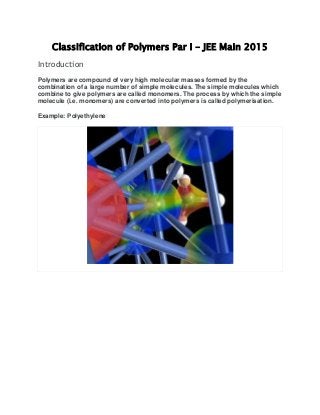Classification of Polymers Par I – JEE Main 2015
- 1. Classification of Polymers Par I – JEE Main 2015 Introduction Polymers are compound of very high molecular masses formed by the combination of a large number of simple molecules. The simple molecules which combine to give polymers are called monomers. The process by which the simple molecule (i.e. monomers) are converted into polymers is called polymerisation. Example: Polyethylene
- 2. All polymers are macromolecule but all macromolecules are not polymers because polymer consist repeating unit of monomer e.g., chlorophyll is a macromolecule but not a polymer. Classification of polymers 1. Classification based on source of availability : They are classified as (i) Natural polymers (ii) Synthetic polymers (iii) Semi-synthetic polymers (i) Natural polymers: The polymers obtained from nature (plants and animals) are called natural polymers. These polymers are very essential for life. They are as under. (a) Starch : It is polymer of glucose and it is food reserve of plant. (b) Cellulose : It is also a polymer of glucose. It is a chief structural material of the plant both starch and cellulose are made by plants from glucose produced during photosynthesis. (c) Proteins : These are polymers of α-amino acids, they have generally 20 to 1000 α amino acid joined together in a highly organized arrangement. These are building blocks of animal body and constitute an essential part of our food. (d) Nucleic acids : These are polymers of various nucleotides. For example RNA and DNA are common nucleotides. ∙ It may be noted that polymers such as polysaccharides (starch, cellulose), proteins and nucleic acids etc. which control various life processes in plants and animals are also called biopolymers. (ii) Synthetic polymers : The polymers which are prepared in the laboratories are called synthetic polymers. These are also called man made polymers. For example polyethene, PVC nylon, teflon, bakelite terylene, synthetic rubber etc. (iii) Semisynthetic polymers : These polymers are mostly derived from naturally occurring polymers by chemical modifications. For example cellulose is naturally occurring polymers, cellulose on acetylation with acetic anhydride in the presence of sulphuric acid forms cellulose diacetate polymers. It is used in making thread and materials like films glasses etc. Vulcanized rubber is also an example of semisynthetic polymers used in making tyres etc. gun cotton which is cellulose nitrate used in making explosive.
- 3. Semi-synthetic polymers : Rayon and other cellulose derivatives like cellulose nitrate, cellulose acetate etc., are semi-synthetic polymers. These are thermoplastic polymers. Viscose rayon in the form of a thin transparent film is known as cellophane. Cellophane is softened with glycerol. Unlike plastic sheets it absorbs water. Rayon : Rayon is a man made material which consists of purified cellulose in the form of long fibres. Cellulose is treated with cold NaOH solution to purify it and then treated with CS2 to form a viscose solution. This is why rayon is sometimes called viscose rayon. This solution is allowed to pass through fine pores in metal cylinder, into a dilute solution of H2SO4. This results in the formation of long fibres. Rayon fibre is chemically identical to cotton but has a shine like silk. As such rayon is also known as artificial silk. Rayon is used on a large scale for making textiles, tyre-chord, carpets and surgical dressings. Unlike fully synthetic polymers, it absorbs moisture and is bio-degradable. Find this blog useful??? Give your feedback in comment box. Create free account to get free online live lectures about JEE Main / MH-CET 2015. Happy eLearning! - Team Ednexa Follow us on Facebook, Twitter & Google+ for latest updates.

